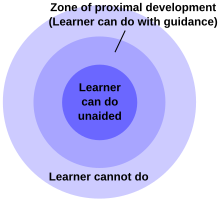
The zone of proximal development (ZPD) is a concept in educational psychology. It represents the space between what a learner is capable of doing unsupported and what the learner cannot do even with support. It is the range where the learner is able to perform, but only with support from a teacher or a peer with more knowledge or expertise (a "more knowledgeable other"). [1] The concept was introduced, but not fully developed, by psychologist Lev Vygotsky (1896–1934) during the last three years of his life.[2] Vygotsky argued that a child gets involved in a dialogue with the "more knowledgeable other", such as a peer or an adult, and gradually, through social interaction and sense-making, develops the ability to solve problems independently and do certain tasks without help. Following Vygotsky, some educators believe that the role of education is to give children experiences that are within their zones of proximal development, thereby encouraging and advancing their individual learning skills and strategies.[3]
- ^ Zone of proximal development. (2009). In Penguin dictionary of psychology. Retrieved from Credo Reference database
- ^ Yasnitsky, A. (2018). Vygotsky: An Intellectual Biography. London and New York: Routledge BOOK PREVIEW
- ^ Berk, L & Winsler, A. (1995). Vygotsky also felt that social interaction was very important when it came to learning. "Vygotsky: His life and works" and "Vygotsky's approach to development". In Scaffolding children's learning: Vygotsky and early childhood learning. Natl. Assoc for Educ. Of Young Children. p. 24